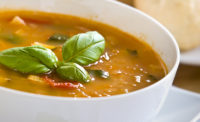Frozen and Prepared Foods Trends in 2015

Last spring, as national publications reported declining sales in their foods, the American Frozen Food Institute (AFFI), McLean, Va., launched a national  campaign to encourage consumers to take a fresh look at frozen foods. With growing competition from food establishments offering healthful options on their fast food menus and well-prepared foods available in supermarkets, the frozen and commercially prepared food industry is trying to capture consumers who feel they have less need for these foods.
campaign to encourage consumers to take a fresh look at frozen foods. With growing competition from food establishments offering healthful options on their fast food menus and well-prepared foods available in supermarkets, the frozen and commercially prepared food industry is trying to capture consumers who feel they have less need for these foods.
According to a report released last spring from the International Food Information Council (IFIC), Washington, D.C., unlike mainstream frozen foods, sales of natural frozen foods with “real” ingredients increased, which points to our desire to have the convenience without compromising our diet. With this in mind, frozen food manufacturers will continue to communicate their message of freezing as “nature’s pause button” in 2015 in an effort to capture a larger market. Refrigerated prepared foods will echo the message that they are good options for busy days when you need to someone else to do the work for you and do it the way you would have done it.
The overall theme of 2015 will be looking toward refrigerated and frozen food items that consumers feel are a good partner in the kitchen. If the industry is prepared to provide foods that contain simple, wholesome, “you-can-read-them” ingredients, then these items have the potential to become a valued part of the American diet. Additionally, if frozen and prepared foods are designed to help consumers meet their diet needs and the needs of their children, they will turn to these foods as an appreciated partner in their kitchen.
In line with these trends, The Guiding Stars Licensing Co., Scarborough, Maine, also predicts the following for 2015:
Recipe makeover
Increasing numbers of consumers are looking for frozen/prepared foods created the way they would if they had the time to do so. To meet this need, mainstream and natural frozen/prepared food manufacturers alike will seek to modify their recipes to include “real,” recognizable ingredients. For consumers, the ingredients list is increasingly becoming just as important as whether a product is “natural.” Manufacturers that are able to produce “clean,” less processed products with fewer ingredients will attract consumers and position their products as a valuable tool when it comes to “clean eating.”
More Guiding Stars rated foods
Over the past few years, we have seen an increase in the number of Guiding Stars rated frozen foods, a trend we don’t expect to change in 2015. Consumers will look for more nutrient-rich frozen foods that meet their caloric needs and are limited in sodium, saturated fat and other negative attributes. What manufacturers provide on the nutrition facts panel will determine whether a consumer chooses a product or passes it over.
Front-of-package diet trend call-outs
While the FDA regulates call outs such as “low sodium” or “light,” the front of the package remains a key communication tool manufacturers use to highlight their product. In 2015, as companies work to make frozen and prepared foods part of our diet, call outs aligned with today’s trends of eating gluten-free, Paleo and more will be desirable by consumers. Recognizing that individuals following specific diets are often looking for a “partner” to help them meet their goals, prepared and frozen foods have the opportunity to fill that role.
How frozen produce has a place at the dinner table
Americans know that they need to eat more fruits and vegetables—they just don’t know that frozen produce is as good as fresh. If the message can get through that frozen vegetables are a healthful choice to have on hand when busy and can’t get to the market, then consumers will make frozen produce a regular on their shopping list.
The kids rule
Market research publisher Packaged Facts, New York, estimates that sales of food marketed specifically to kids will reach nearly $30 billion by 2018. The growing need for wholesome, age-appropriate convenient foods is driving this sales growth along with busy caregivers that see a need for these foods, but also want to feel good about what they are providing their children. 2015 will see more packaged foods on store shelves that are perfect for school lunch, the soccer field and even a busy night, which meet the needs of children and are prepared with wholesome ingredients.
Helping the home cook
2015 will see more people getting into their kitchen when they can and leaning on well-prepared refrigerated foods to do some of the work to make a “half-scratch” meal come together in no time. Diced and steamed vegetables as well as healthfully prepared marinated meats and pre-cooked sides are just some of the foods consumers will look for to meet their needs.
Whatever trends the New Year brings, sales and statistics show that frozen foods are here to stay.
Looking for a reprint of this article?
From high-res PDFs to custom plaques, order your copy today!






